I always like to re-read an old favourite book during the year the last book of last year I read was John Steinbeck’s masterpiece East of Eden. Looking at my old battered paperback edition it is the 5th time I have read it. Although I’m sure somehow it is more than that. By the way I do have a very good 1952 US 1st edition in my collection.
East of Eden spans the years in American history from the Civil War to the First World War. Touching on the Indian Wars and the exploitation of the Chinese in California brought in the build the railroads. It is a rambling novel a quality I have come to appreciate. Themed on the biblical story of Cane and Abel.
John Steinbeck wrote in his book ‘Journal of a Novel: The East of Eden Letters’ how he was writing the book for his sons.
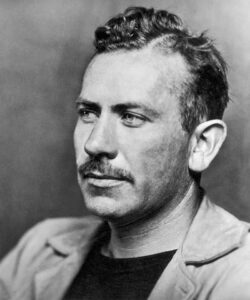
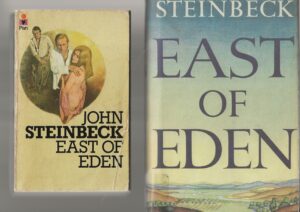
‘And so I will tell them one of the greatest, perhaps the greatest story of all-the story of good and evil, of strength and weakness, of love and hate, of beauty and ugliness. I shall try to demonstrate to them how these doubles are inseparable-how neither can exist without the other and how out of their groupings creativeness is born.’
Over the course of 276 days in 1952, Steinbeck wrote the first draft of East of Eden a book he considered his ultimate test as a writer. He wrote a daily letter to his editor while writing the book. Through them, Steinbeck explored himself, his creative process, his love for writing, and his family life, for he had just married his third wife, Elaine Scott, the year before. Steinbeck, according to Elaine Scott, considered East of Eden his magnum opus, his greatest novel.
In 1997 Margaret and I went to California partly in search of Steinbeck’s ‘The Grapes of Wrath’, we had driven out east into the Mojave Desert. At Barstow, a one street town, I waited and wrote in my diary.
‘Dinner that night in an old fashioned busy diner was good. Walking back to my motel the air was cool, the stars brilliant in the night sky. The klaxon of a passing train on the Santa Fe railroad recalled an older age.’
The ‘Joad’s’, Steinbeck’s dispossessed Oklahoma farmers, victims of the ‘Great Depression’, were haunting me, it was as if I was waiting for them. They had to cross the Colorado River on the old route 66, the main migrant road, as Steinbeck called it, and into the terrible ‘frightening’ desert.
The ‘Joad’s’ stopped in Barstow to re-fill their Hudson super-six, half car half truck, that brought them a thousand miles west from Oklahoma, dreaming of a new life of plenty in California.
For us re-fuelling was easy at the out-of-town shopping area, an oasis in the desert, with ninety five outlets. We headed back west through a landscape of sagebrush and Joshua trees dotting the flat landscape hemmed in by distant red and black mountains. Even for us in an air-conditioned car the desert had an eerie quality. It was to California I had come in search of John Steinbeck’s ‘The Grapes of Wrath’, we had driven out east into the Mojave Desert. At Barstow, a one street town, I waited.
Dinner that night in an old fashioned busy diner was good. Walking back to my motel the air was cool, the stars brilliant in the night sky. The klaxon of a passing train on the Santa Fe railroad recalled an older age.
The ‘Joad’s’, Steinbeck’s dispossessed Oklahoma farmers, victims of the ‘Great Depression’, were haunting me, it was as if I was waiting for them. They had to cross the Colorado River on the old route 66, the main migrant road, as Steinbeck called it, and into the terrible ‘frightening’ desert. They are derogatorily called ‘Okies’ . Tom Joad learns Okie used to mean you were from Oklahoma. ‘Now it means you’re a dirty son-of-a-bitch. Okie means your scum.’
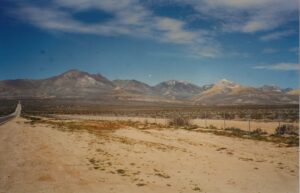
The ‘Joad’s’ stopped in Barstow to re-fill their Hudson super-six, half car half truck, that brought them a thousand miles west from Oklahoma, dreaming of a new life of plenty in California.
For us re-fuelling was easy at the out-of-town shopping area, an oasis in the desert, with ninety five outlets. We headed back west through a landscape of sagebrush and Joshua trees dotting the flat landscape hemmed in by distant red and black mountains. Even for us in an air-conditioned car the desert had an eerie quality.
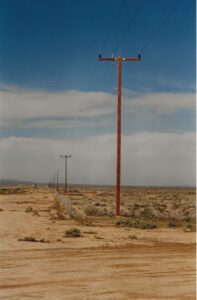
In Salinas Town we found the Steinbeck House, built in 1897, is at 132 Central Avenue, described in ‘East of Eden’ as ‘an immaculate and friendly house, grand enough, but not pretentious….’
John Steinbeck was born here in 1902. Today it is a restaurant run by the Valley Guild, a volunteer, nonprofit organization. John wrote two books here in the front bedroom ‘The Red Pony’ and ‘Tortilla Flat’. In the old part of the town is The National Steinbeck Centre.
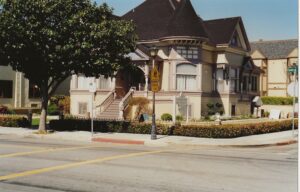
We passed through Carmel on the way to Monterey. Carmel in Steinbeck’s youth was a community of ‘starveling writers and unwanted painters’. Today it is known for the homes of the rich and famous.
In Monterey, Cannery Row is still there but no longer the ‘stinking sardine canneries of corrugated iron’ and ‘honky-tonks’. Today they are antique and gift shops.
“Don’t read books sir” said the roadman working down a hole I asked for directions, but he shouted down the hole. “Ed there’s a guy here looking for some writers’ museum”. “Why sure two blocks to the left” a voice emerged from the depths, followed by a helmeted head. “My Ma knew Steinbeck. Drunken bum she reckoned.Some older people in these parts don’t like his books much. But he put this town on the map yes sir”.
His words did not shock me. For Steinbeck’s best work was about the dispossessed and the poor who had a hard time in California. Criticism of his work by locals did drive him away from his native state. However after twenty years he returned and wrote about Monterey in ‘Travels with Charley’.
‘The place of my origin had changed, and having gone away I had not changed with it. In my memory it stood as it once did and its outward appearance confused and angered me’.
Steinbeck in my opinion wrote four great books Of Mice and Men, The Grapes of Wrath, East of Eden, and Travels with Charley all of which are like old friends to me and I have read many times.